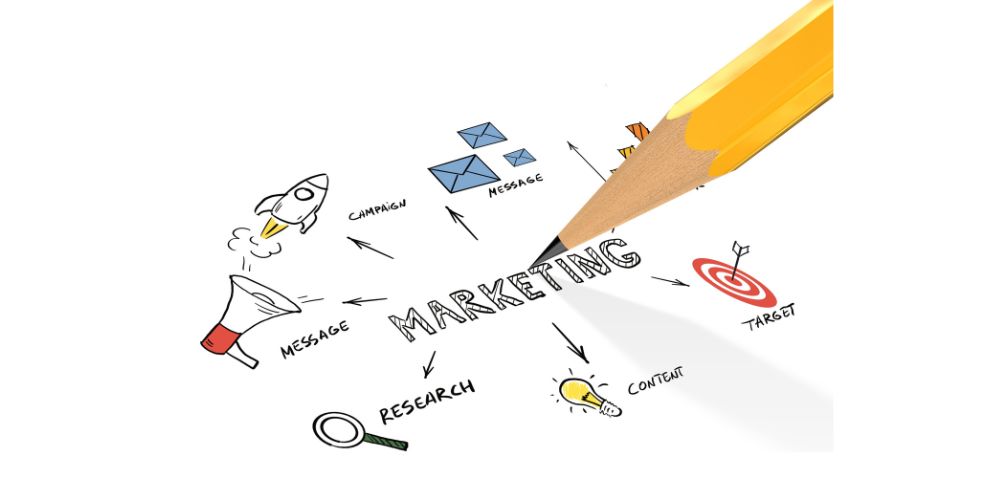What’s the connection between driving to a friend’s house, hiking a trail, and doing marketing campaigns? You need to carefully follow instructions for each.
We all depend on directions in our daily lives. They can help you make decisions, increase the productivity of your workforce, and travel as swiftly as possible when used properly.
But it might cost you more than just your gas money if you don’t follow the directions. When it comes to marketing plans, lacking a defined objective destroys web traffic, erodes consumer interest in brands, and costs American businesses an astounding $400 billion annually.
Even if creating a marketing plan is not an easy effort, it may be improved by using best practices, strategic advice, and real-world examples from globally successful companies.
What is a marketing plan?

A marketing plan is a strategic document that serves as a roadmap for marketing programs and ideas. These vital road maps include specifics on your current location, your destination, and your planned route.
There are seven main sections that make up the average marketing strategy:
- Creating an executive summary
- Talking about the mission statement
- Listing marketing goals
- SWOT analysis
- Doing market research
- Dreating a marketing plan
- Establishing a budget
A marketing plan’s effectiveness at achieving its objectives will increase with its level of detail.
As you might expect, marketers that take the time to create a detailed marketing plan have the following advantages:
- 674% more organized marketers are likely to report success.
- Setting goals increases marketing success by 377% compared to those who don’t.
It is clear that a strong marketing strategy creates doors for other types of corporate success, yet the strategy is at best neglected. If they don’t have a clear path to growth, more than three out of four small business owners don’t have a comprehensive marketing strategy. To scale brands at any stage of development, a comprehensive marketing strategy must be developed.
Marketing plan examples from every industry

Making a plan of action is much easier when the foundation is already in place. The following marketing plans, which were drawn from actual businesses and brands all over the world, demonstrate various methods for planning, developing, and carrying out marketing strategies.
1. Coca-Cola
Titan of the beverage industry. All seven components of a comprehensive marketing strategy are covered in a video strategy released by Coca-Cola. The proposal explains the main content objectives for the upcoming year and focuses on how the brand’s original concepts might be practically incorporated into the current strategy.
2. Visit Baton Rouge
Millions of dollars are made annually only from Tourism in the Louisiana region around Baton Rouge. In order to position the city more effectively and develop long-term interest-generating methods, Visit Baton Rouge developed its marketing plan. A detailed description of various locations, occasions, and calendars is provided in this 38-page booklet, along with suggested success metrics.
3. HubSpot
This marketing plan template was developed by the SaaS company HubSpot and includes a business overview, SWOT matrix, market strategy, budget, and other crucial components. You may use the information on it to make informed choices about the positioning of your business and your marketing efforts as a whole.
4. Contently
Popular SaaS Content In order to create the next campaigns, Contently created a graphic marketing plan. The strategy presents its approach in a “waterfall” fashion, with goals merging into implementation strategies that eventually result in success measures. The work offers a great summary of the essential elements of a marketing plan, despite being much more informal than other examples on this list.
5. Monday.com
A project management tool called Monday.com gives all registered users access to internal templates. This marketing strategy provides a number of categories and subcategories that use graphs and charts to track project success. In-app objectives and KPIs with specifics, such as columns for a predicted cost range, are available.
Approaches to a marketing plan

Now that you are aware of what a marketing strategy entails, it is time to investigate the initial processes of writing and releasing your first plan. A little research is all you need to get started once you’ve established some fundamental starting points.
Select your goals.
Without a goal in sight, directions are meaningless. Create some worthwhile objectives for your marketing campaign that take your brand’s beliefs, ambitions, and end-of-year plans into account. Use the SMART goal framework wherever possible:
- Specific
- Measurable
- Achievable
- Relevant
- Timely
Your marketing strategy will be more successful if your goals are more specific.
look at your competitors
In the early stages of a Marketing plan, keeping track of your competitors and market share is essential. Spend some time analyzing how others are approaching the problem and how you may do better by using internal processes or competitive analysis tools.
You may want to:
- Conduct an analysis of the competition
- Keep an eye on industry news
- Keep an eye on industry news
- Check out the social media accounts of your competitors Keep in mind that, depending on your demands and time limits, you may want to hire freelancers to conduct your comparative study.
Choose your audience.
The first and most important rule of marketing is to comprehend your target market, including their objectives, ages, values, and demographics. There are various ways to accomplish this, including by using data, developing personas, or highlighting unusual elements in a document.
It is vital to take into account everything that can be important to your audience when creating a marketing strategy, including possible ways to position things so they are pertinent. A customer with a degree in IT, for instance, would be more interested in advertisements that speak to their experience and the problems facing the sector.
If you don’t currently have an idea of who your target market is, think about using tools like Google Analytics or Facebook’s in-platform analytics to pinpoint certain demographic groups.
Develop final KPIs
Key performance measurements serve as the starting point for differentiating between a good and exceptional marketing plan (KPIs). These will be used to gauge the success of your campaign and offer thorough details on what worked, what didn’t, and what you can adjust moving forward.
Every marketing strategy should be based on a distinct set of metrics that are all tailored to the needs of the specific plan. Try the following if you’re looking for specific examples:
- Increasing the number of followers on a social network account
- A specific number of website leads being generated
- Increasing email open rates
For optimum outcomes, keep in mind that your final measurements should follow the SMART technique.
Make your adjustments
The marketing strategy is a live document that needs to be revised frequently to stay relevant. The shelf life of a typical plan is only one to five years, on average, and should be regularly revised during that time.
Look more closely at your previous objectives, rivals, target audience, and KPIs. Do any of these seem dated or out of place? What has changed for the business since it was first published? Make these changes in accordance (and hopefully with members of a team or committee).
Make marketing strategies that will help your company succeed
It is insufficient to just create a marketing plan. Marketing experts should take their time creating a long-lasting strategy in an environment where competition is fierce and ironclad tactics are the norm. The examples given above are a terrific place to start, especially when you develop a strategy that is tailored to your business.
Once your marketing strategy is implemented, keep an eye on your company’s expansion. Find new methods to improve what you already have by optimizing, refining, and doing other things to make it even better. The options are practically endless if you have a solid marketing strategy by your side.


